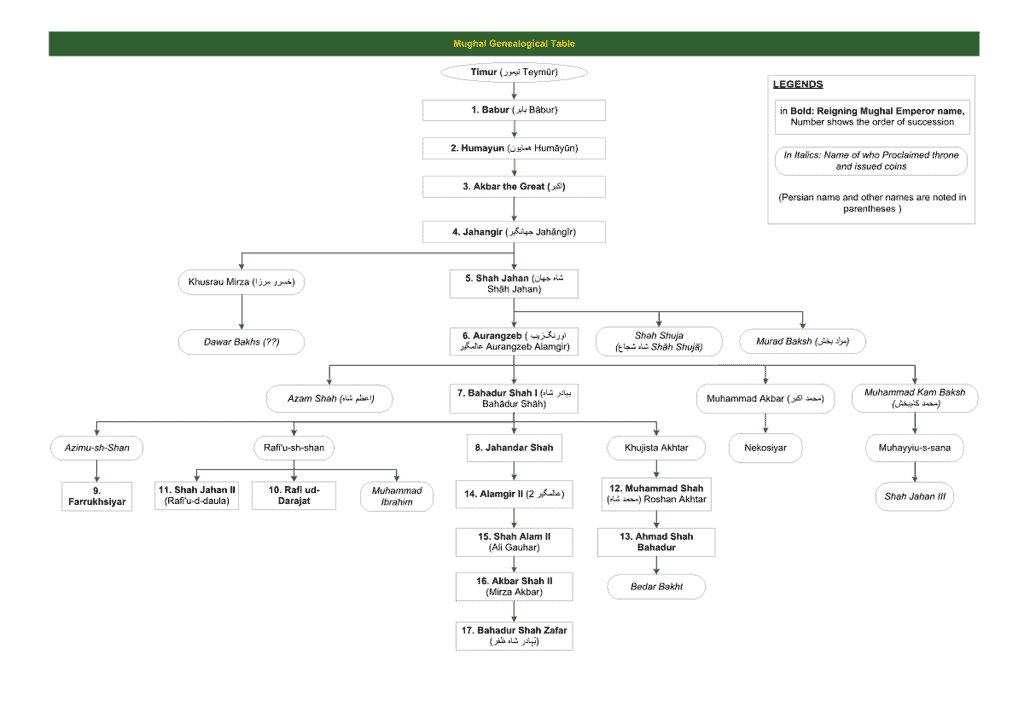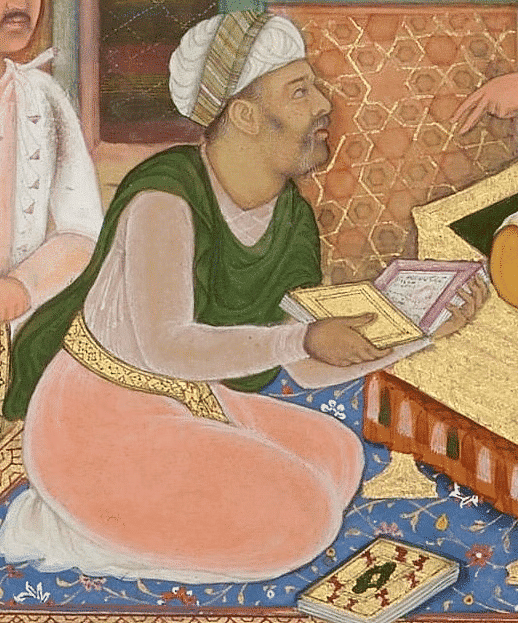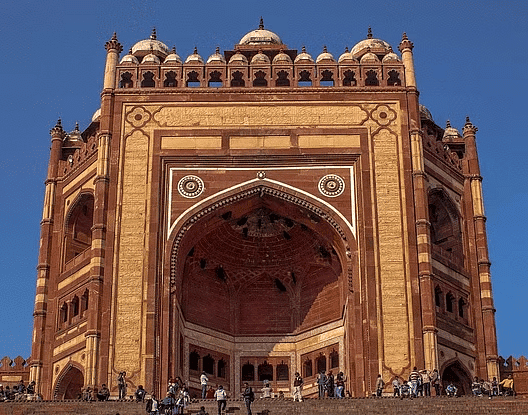Grade 12 Exam > Grade 12 Notes > History for Grade 12 > Chapter Notes: Kings and Chronicles
Kings and Chronicles Class 12 History
The Mughals and Their Empire
- During the sixteenth century, Europeans used the term ‘Mughal’ to describe the Indian rulers of Timurids-Mongols descendant branch.
- The founder of the empire, Zahiruddin Babur, was driven from his Central Asian homeland, Farghana, by the warring Uzbeks.
- He first established himself at Kabul and then in 1526 pushed further into the Indian subcontinent in search of territories and resources for his clan.
- His successor, Nasiruddin Humayun (1530-40, 1555-56) expanded the frontiers of the empire, but lost it to the Afghan leader Sher Shah Sur, who drove him into exile.
- In 1555 Humayun defeated the Surs.
- Jalaluddin Akbar (1556-1605) is considered to be the greatest of all the Mughal emperors.
- He consolidated his empire and made it the largest, strongest and richest kingdom of his time.
- Akbar succeeded in extending the frontiers of the empire to the Hindukush mountains, and checked the expansionist designs of the Uzbeks of Turan (Central Asia) and the Safavids of Iran.
- Akbar had three successors – Jahangir (1605-27), Shah Jahan (1628-58) and Aurangzeb (1658-1707).
- The three rulers maintained and consolidated the various instruments of governance.
- The court was the visible centre of Mughal power.
- After 1707, following the death of Aurangzeb, the power of the dynasty diminished.
- In 1857 the last scion of this dynasty, Bahadur Shah Zafar II, was overthrown by the British.
 Mughal Family tree
Mughal Family tree
The Production of Chronicles
- The production of chronicle (1526 -1707) provides us with the information on the Mughals and their empires.
- The authors of Mughal chronicles were invariably courtiers.
- The histories they wrote focused on events centred on the ruler, his family, the court and nobles, wars and administrative arrangements.
- The titles of the chronicles suggest that in the eyes of their authors the history of the empire and the court was synonymous with that of the emperor.
- Some of the chroniclies are – Akbar Nama – the story of Akbar was written in Persian by Abu’l Fazl, Shahjahan Nama – story of Shah Jahan, Alamgir Nama – the story of Alamgir (a title of the Mughal ruler Aurangzeb).
- Abdul Hamid Lahori is the author of the Badshah Nama, which is the official history in three volumes (daftars) of ten lunar years each.
- Edited versions of the Akbar Nama and Badshah Nama were first published by the Asiatic Society in the nineteenth century.
From Turkish to Persian
- As the Mughals were Chaghtai Turks by origin, Turkish was their mother tongue. Their first ruler Babur wrote poetry and his memoirs in this language.
- But in Mughal court chronicles were written in Persian.
- It was Akbar who consciously set out to make Persian the leading language of the Mughal court.
- Persian was elevated to a language of empire, conferring power and prestige on those who had a command of it. It was spoken by the king, the royal household and the elite at court.
- Later, it became the language of administration.
- Persian became Indianised by absorbing local idioms. A new language, Urdu, sprang from the interaction of Persian with Hindavi.
- Translations of various books were done, like Babur’s memoirs, were translated from the Turkish into the Persian Babur Nama. The Mahabharata was translated as the Razmnama (Book of Wars).
The making of manuscripts
- All books in Mughal India were manuscripts, that is, they were handwritten.
- The centre of manuscript production was the imperial kitabkhana.
- Although it can be translated as library, it was a scriptorium, that is, a place where the emperor’s collection of manuscripts.
 Akbar Nama
Akbar Nama
Question for Chapter Notes: Kings and ChroniclesTry yourself: Who was the founder of the Mughal Empire?View Solution
The Painted Image
- Paintings served not only to enhance the beauty of a book, but were believed to possess special powers of communicating ideas about the kingdom and the power of kings in ways that the written medium could not.
- The historian Abu’l Fazl described painting as a “magical art”.
- It had the power to make inanimate objects look as if they possessed life.
- The production of paintings portraying the emperor, his court and the people who were part of it, was a source of constant tension between rulers and representatives of the Muslim orthodoxy, the ulama.
The Ideal Kingdom
A Divine Light
- Abu’l Fazl placed Mughal kingship as the highest station in the hierarchy of objects receiving light emanating from God (farr-i izadi).
- He was inspired by a famous Iranian sufi, Shihabuddin Suhrawardi (d. 1191) who first developed the idea of a hierarchy in which the Divine Light was transmitted to the king who then became the source of spiritual guidance for his subjects.
A Unifying Force
- Mughal chronicles present the empire as comprising many different ethnic and religious communities.
- Abu’l Fazl describes the ideal of sulh-i kul (absolute peace) as the cornerstone of enlightened rule.
- In sulh-i kul all religions and schools of thought had freedom of expression but on condition that they did not undermine the authority of the state or fight among themselves.
Just Sovereignty as Social Contract
- Abu’l Fazl defined sovereignty as a social contract: the emperor protects the four essences of his subjects, namely, life (jan), property (mal), honour (namus) and faith (din), and in return demands obedience and a share of resources.
 Abul Fazl
Abul Fazl
Capitals & Courts
Capital Cities
- The heart of the Mughal Empire was its capital city, where the court assembled, which frequently shifted during the sixteenth and seventeenth centuries.
- Babur took over the Lodi capital of Agra. During the 1560s Akbar had the fort of Agra constructed with red sandstone quarried from the adjoining regions.
- In the 1570s he decided to build a new capital, Fatehpur Sikri. The enormous arched gateway (Buland Darwaza) was meant to remind visitors of the Mughal victory in Gujarat.
- Akbar commissioned the construction of a white marble tomb for Shaikh Salim Chishti next to the majestic Friday mosque at Sikri.
- In 1585 the capital was transferred to Lahore to bring the north-west under greater control.
- In 1648 the court, army and household moved from Agra to the newly completed imperial capital, Shahjahanabad. It was a new addition to the old residential city of Delhi, with the Red Fort, the Jama Masjid, a tree-lined esplanade with Fig. 9.8 The Buland Darwaza, Fatehpur Sikri 237 bazaars (Chandni Chowk) and spacious homes for the nobility.
The Mughal Court
- The Mughal court’s physical arrangement focused on the sovereign, mirrored his status as the heart of society.
- In court, status was determined by spatial proximity to the king. The place accorded to a courtier by the ruler was a sign of his importance in the eyes of the emperor.
- The forms of salutation to the ruler indicated the person’s status in the hierarchy. Besides, there were explicit protocols that governed diplomatic envoys at the Mughal court.
- On special occasions such as the anniversary of accession to the throne, Id, Shab-i barat and Holi, the court was full of life.
 Buland Darwaza
Buland Darwaza
Titles and Gifts
- Grand titles were adopted by the Mughal emperors at the time of coronation or after a victory over an enemy.
- The granting of titles to men of merit was an important aspect of Mughal polity. Titles could be earned or paid for.
- A courtier never approached the emperor empty handed. In diplomatic relations, gifts were regarded as a sign of honour and respect.
Question for Chapter Notes: Kings and ChroniclesTry yourself: What was the purpose of the Buland Darwaza in Fatehpur Sikri?View Solution
The Imperial Household
- The Mughal household consisted of the emperor’s wives and concubines, his near and distant relatives and female servants and slaves.
- Polygamy was practised widely in the Indian subcontinent, especially among the ruling groups.
- marriage was a way of cementing political relationships and forging alliances. The gift of territory was often accompanied by the gift of a daughter in marriage.
- In the Mughal household a distinction was maintained between wives who came from royal families (begams), and other wives (aghas) who were not of noble birth.
The Imperial Officials
Recruitment and rank
- One important pillar of the Mughal state was its corps of officers, also referred to by historians collectively as the nobility, which was recruited from diverse ethnic and religious groups. For members of the nobility, imperial service was a way of acquiring power, wealth and the highest possible reputation.
- Turani and Iranian nobles were present from the earliest phase of carving out a political dominion.
- Two ruling groups of Indian origin entered the imperial service from 1560 onwards – the Rajputs and the Indian Muslims.
- Iranians gained high offices under Jahangir, whose politically influential queen, Nur Jahan (d. 1645), was an Iranian.
- The nobles participated in military campaigns with their armies and also served as officers of the empire in the provinces.
- Each military commander recruited, equipped and trained the main striking arm of the Mughal army, the cavalry.
Information and Empire
- The Mir bakhshi supervised the corps of court writers (waqia nawis) who recorded all applications and documents presented to the court, and all imperial orders (farman).
- The akhbarat contained all kinds of information such as attendance at the court, grant of offices and titles, diplomatic missions, presents received, or the enquiries made by the emperor about the health of an officer.
- The Mughal chroniclers usually portrayed the emperor and his court as controlling the entire administrative apparatus down to the village level.
 Mir Bakshi
Mir Bakshi
Question for Chapter Notes: Kings and ChroniclesTry yourself: What was the purpose of polygamy in the Mughal household?View Solution
Beyond the Frontiers
The Safavids and Qandahar
- The diplomatic relationships and conflicts of Mughals with neighbouring political powers. reflect some tension and political rivalry arising from competing regional interests.
- The relation of Mughal kings and the neighbouring countries of Iran and Turan hinged on the control of the frontier defined by the Hindukush mountains that separated Afghanistan from the regions of Iran and Central Asia. A constant aim of Mughal policy was to ward off this potential danger by controlling strategic outposts – notably Kabul and Qandahar.
The Ottomans: pilgrimage and Trade
- The relationship between the Mughals and the Ottomans was marked by the concern to ensure free movement for merchants and pilgrims in the territories under Ottoman control.
Jesuits at the Mughal Court
- By the end of the fifteenth century, Portuguese merchants entered India after the discovery of a direct sea route. The Portuguese king was interested in the propagation of Christianity with the help of the missionaries of the Society of Jesus (the Jesuits). as the Christian missions to India during the sixteenth century were part of this process of trade and empire building.
- Akbar was curious about Christianity and dispatched an embassy to Goa to invite Jesuit priests. The first Jesuit mission reached the Mughal court at Fatehpur Sikri in 1580 and stayed for about two years. The Jesuits spoke to Akbar about Christianity and debated its virtues with the ulama. Two more missions were sent to the Mughal court at Lahore, in 1591 and 1595.
Questioning Formal Religion
- The high respect shown by Akbar towards the members of the Jesuit mission impressed them deeply. They interpreted the emperor’s open interest in the doctrines of Christianity as a sign of his acceptance of their faith.
- Akbar’s quest for religious knowledge led to interfaith debates in the ibadat khana at Fatehpur Sikri between learned Muslims, Hindus, Jains, Parsis and Christians.
- Akbar’s religious views matured as he gathered knowledge about their doctrines. he moved away from the orthodox Islamic ways of understanding religions towards a self-conceived eclectic form of divine worship focused on light and the sun.
Summary
- The production of chronicle (1526 -1707) provides us with the information on the Mughals and their empires.
- The name Mughal is derived from Mongol.
- From Turkish to Persian – Mughal court chronicles were written in Persian.
- The making of manuscripts – all books in Mughals was manuscripts i.e. they were handwritten.
- The Akbarnama and Badshanama – among the important illustrated Mughal official histories the Akbarnama and Badshanama.
- A unifying force – sulh-i kul – Abu’l Fazl describes the ideal sulh-i-kul (absolute peace) .
- Capitals and courts – capital city – the heart of Mughal empire is capital city where the court assembled.
- Titles and Gifts – The granting of titles to men of merit was an important aspect of Mughal policy.
- Mughal kings commissioned court historians to write accounts. These accounts recorded the event of the emperor’s time.
- Babur laid the foundation for the Mughal Empire in India by defeating the last Lodhi King Ibrahim Lodhi through the battle of Panipat.
- Modern historians writings in English have termed this original text or accounts of texts as chronicles, as they present a continuous chronological record of events.
- The creation of a manuscript involved a number of people performing a variety of tasks.
- Painters too were involved in the production of Mughal manuscripts.
- Babur took over the Lodi capital of Agra.
- During the 1560s Akbar had the fort of Agra constructed with red sandstone quarried from the adjoining regions.
- In the 1570s he decided to build a new capital, Fatehpuri sikri.
- The keeping of exact and detailed records was a major concern of the Mughal administration.
- Akbar was curious about Christianity and dispatched an embassy to Goa to invite Jesuit priests.
- The first Jesuit mission reached the Mughal court at Fatehpur Sikri in 1580 and stayed for about two years.
- The Jesuit spoke to Akbar about Christianity and debated its virtues with the ulama. Two more missions were sent to the Mughal court at Lahore in 1591 and in 1595.
The document Kings and Chronicles Class 12 History is a part of the Grade 12 Course History for Grade 12.
All you need of Grade 12 at this link: Grade 12
|
32 videos|284 docs|31 tests
|
FAQs on Kings and Chronicles Class 12 History
| 1. What were the Mughals and their empire? |  |
Ans. The Mughals were a Muslim dynasty that ruled over a vast empire in the Indian subcontinent from the 16th to the 19th century. Their empire, known as the Mughal Empire, extended across present-day India, Pakistan, Afghanistan, and Bangladesh.
| 2. What is the significance of the production of chronicles in Mughal history? |  |
Ans. The production of chronicles played a crucial role in Mughal history as it served as a means to document and preserve the history, achievements, and events of the empire. Chronicles served as historical records and provided valuable insights into the administration, cultural practices, and political developments of the Mughal Empire.
| 3. How did the Mughals depict their empire through the painted image? |  |
Ans. The Mughals used the painted image as a medium to depict their empire by showcasing various aspects of their society, including courtly life, religious rituals, and architectural achievements. These paintings often portrayed Mughal emperors, their courts, and important events, providing a visual representation of the grandeur and richness of the Mughal Empire.
| 4. What was the ideal kingdom according to the Mughals? |  |
Ans. According to the Mughals, the ideal kingdom was characterized by strong central authority, just governance, religious tolerance, and cultural patronage. The Mughal emperors aimed to establish a harmonious and prosperous empire where people of different religions and backgrounds could coexist peacefully.
| 5. Who were the imperial officials in the Mughal Empire? |  |
Ans. The imperial officials in the Mughal Empire were responsible for the administration and governance of the empire. They included high-ranking officials such as the wazir (prime minister), diwan (revenue officer), and mir bakshi (chief military officer). These officials played a crucial role in maintaining the stability and functioning of the Mughal Empire.
Related Searches





















